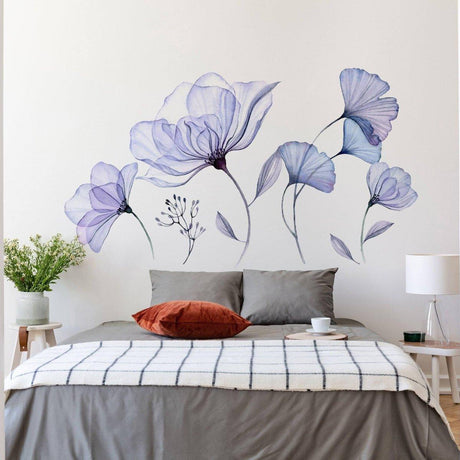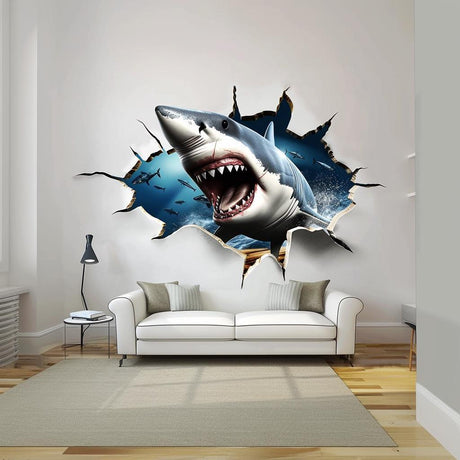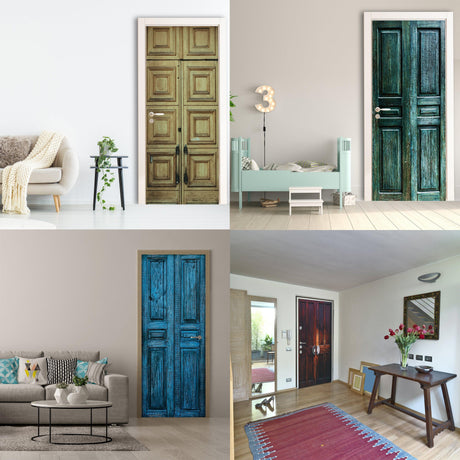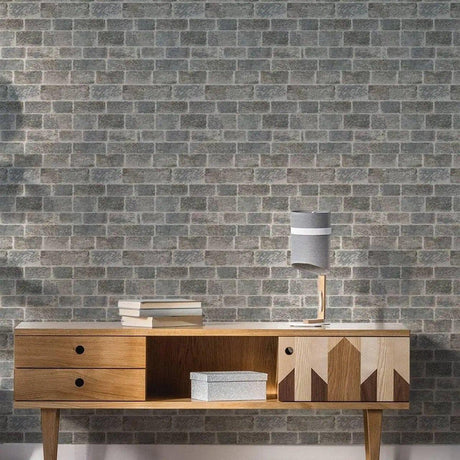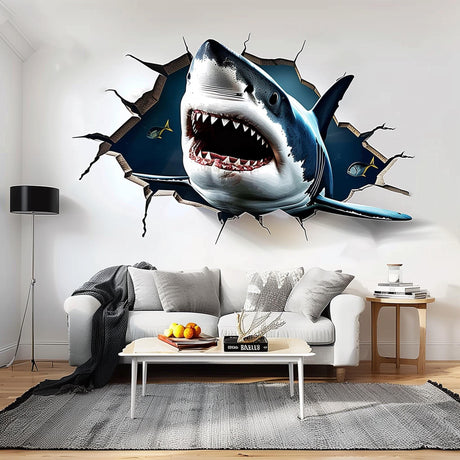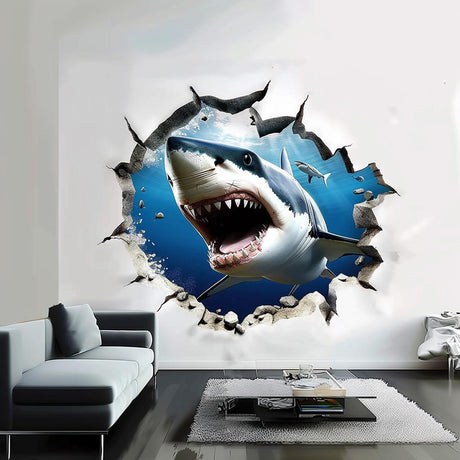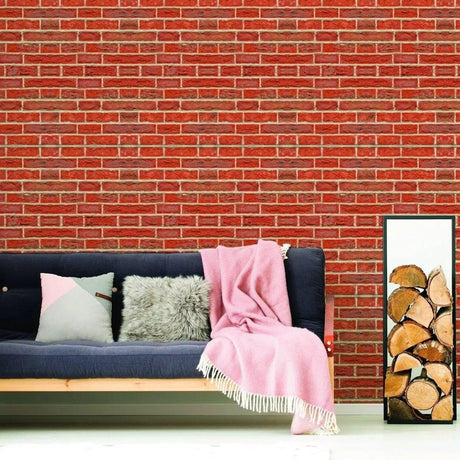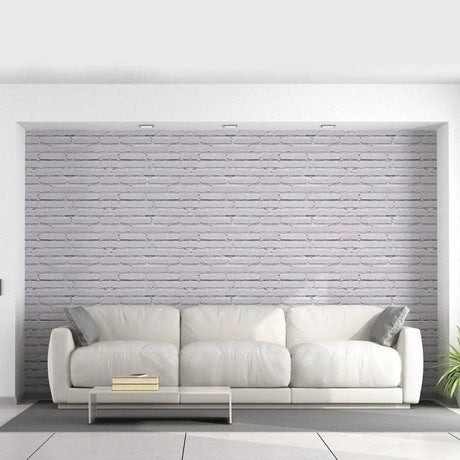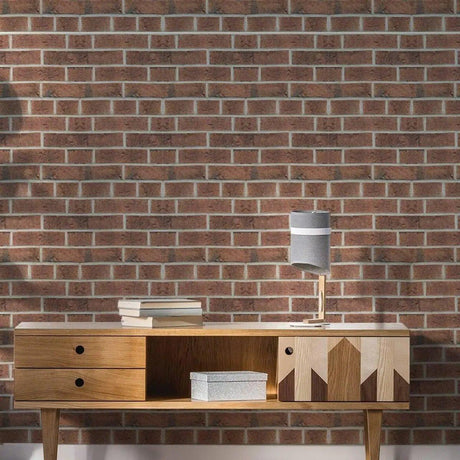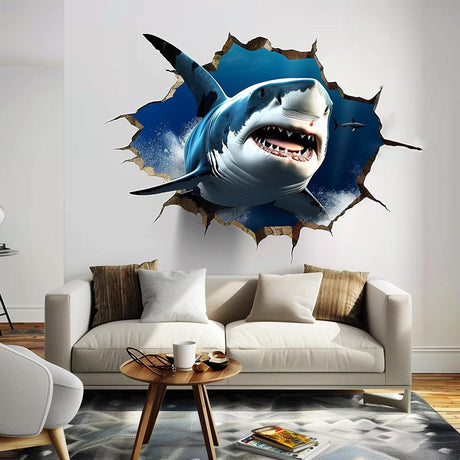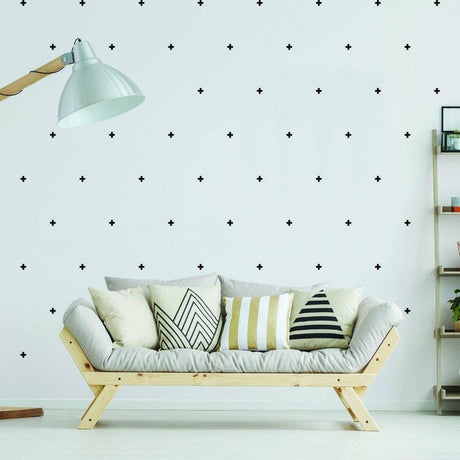The living room carries most of the visual load in a home. Guests see it first, family spends the most time here, and every design mistake is always in sight. At the same time, you rarely want a full renovation just to fix a blank or awkward wall. Wall decals for living room interiors solve this problem cleanly. They give you structure, color, and a focal point without touching wiring, plaster, or heavy furniture.
Flat vinyl graphics work better than extra objects when space is limited. You do not add more shelves to dust or frames to hang. You work directly with the wall plane and turn it into a tool: it can set the mood behind the sofa, frame the TV zone, or visually extend a low ceiling. Because living room wall decals are removable, you can adjust the layout when you move, repaint, or change furniture, which is critical for renters in the US and in European cities like Tallinn or Berlin.
How can wall decals for living room change your space without renovation?
Wall decals for living room walls change the way you read the room. Instead of seeing a random mix of sofa, TV, and shelves, you see clear blocks: a main focal wall, a media zone, and calmer side walls. Graphics pull these elements together so the room stops looking like a set of separate pieces pushed to the edges.
A large decal behind the sofa can act like an invisible headboard. It sets the width of the seating zone and stops the eye from sliding off into an empty wall. A vertical composition near a window can balance heavy curtains or a tall bookcase on the other side. Even a simple band of color or a set of shapes behind the TV can reduce the contrast between the black screen and a bright wall, making the whole living room calmer.
Many apartments in the US, Estonia, and Germany share the same issue. The living room is part of an open plan with the kitchen or hallway. Living room wall stickers help mark where the common space ends and the relaxing zone starts. You can use softer graphics around the sofa and leave the kitchen area cleaner and more technical. This boundary can be purely visual but still very clear for anyone entering the room.
You also avoid the typical trap of overfilling the room. Instead of adding more furniture to "finish" a wall, you use living room stickers to give it enough visual weight. You keep floor space open, which matters in small European flats and in compact American condos, and still get a finished, thought through look.
Which walls and zones are best for living room wall decals and wall art stickers living room?
Not every wall needs graphics. Good decorations for living room wall layouts start with the walls that carry real work: behind the sofa, around the TV area, near the dining table if it shares the room, and sometimes near the entrance into the space. These are the walls people look at without thinking while sitting, talking, or watching something.
Behind the main sofa is usually the strongest position. This wall defines the seating zone, often the center of the living room. Living room wall decals placed here can stretch the sofa visually, align side tables and lamps, or highlight the central seat. If the sofa is short but the wall is long, a wide decal keeps the area from feeling empty. If the wall is narrow, a vertical layout can push the ceiling visually higher.
The media wall is the second key zone. Here, wall art stickers living room designs should support the screen, not fight it. Calm patterns, abstract shapes, or soft gradients work better than very detailed scenes. The goal is to frame the TV and any console or shelf so they feel built into the wall instead of floating in a white field.
Other good zones include:
- a side wall that frames a reading corner or armchair
- the wall behind a small dining table in an open plan living room
- the wall near the entrance that sets the tone as you walk in
Each zone can carry a different level of visual intensity. The main sofa wall can handle a stronger design. The reading corner can use a softer motif that supports relaxation. The dining wall can lean toward rhythm and order so chairs and table feel anchored.
When planning, look at how people move through the room. Graphics should not fight doors, radiators, or structural beams. They should line up with existing axes and edges. If you align decals with furniture and architecture, the room will feel coherent even if the actual elements are simple.
How to choose design styles and living room wall quotes that match your interior?
The best wall decal for living room use matches three things at once: the architecture, the furniture, and the way you actually live in the room. It is not enough to pick a pretty picture or random text. You need a design that sits comfortably in your space, not one that looks imported from a catalog.
If your interior leans minimal, think in terms of clear shapes and restrained palettes. A single line based graphic, a large but simple arc, or a quiet pattern behind the sofa can be enough. In such rooms, living room wall quotes should be short and set in clean typography. One or two words often work better than full sentences. Text in this context acts as an accent, not as a manifesto.
In more eclectic or cozy interiors, you can afford more detail and color. Here, decorations for living room wall setups may include botanical motifs, city skylines, abstract art, or more expressive quotes. Still, it pays to stay within a limited color range. Graphics should connect existing textiles, rugs, and furniture colors instead of adding a new competing tone.
A simple selection framework:
- match the main decal color to something already in the room (rug, cushions, curtains)
- avoid typography styles that conflict with furniture style (for example, ultra modern fonts in a classic room)
- keep most living room wall quotes above eye level so they do not dominate conversations
- use larger, simpler shapes in small or dark rooms and reserve complex scenes for larger, bright walls
Living room wall decals do not have to shout to be effective. Often, the best result comes from graphics that support your existing taste quietly. When you choose designs that feel like a natural extension of your furniture and lighting, guests will feel that the room is complete without being able to point to a single dominating element.
How to plan and install a wall decal for living room so it looks balanced and clean?
Planning and installation have as much influence on the result as the design itself. A well chosen decal placed carelessly will always look off. A moderate design placed on the right axis and at the right height will often look like a custom mural.
Start by defining the composition. Sit in your usual spots in the living room and look straight ahead. These sight lines matter more than what you see when standing in the doorway. Mark with painter’s tape where your eye naturally rests on the wall. This is where the center of the main composition should sit, not too high and not too low.
Before you stick anything, sketch the idea on paper and then on the wall using tape. Outline the approximate size of the future living room wall decals and check how they relate to the width of the sofa, the height of the TV, and the edges of windows. If the decal is wider than the sofa, does it feel intentional. If it is narrower, does it still center well.
When you move to actual installation:
- clean the wall to remove dust and small marks
- mark a horizontal line and central axis with tape
- peel back only part of the backing and align the top edge
- smooth the decal from the center outward with a soft cloth
- step back several times to adjust before committing fully
Complex wall decal ideas for living room spaces can be built from several pieces. In that case, place the central element first, then add satellites around it. This helps keep the main composition stable even if you adjust smaller pieces. For quote based designs, pay extra attention to rotation. Even a slight tilt becomes visible when letters sit near shelves or frames.
If you ever need to remove or reposition living room wall stickers, peel slowly at a shallow angle and, if needed, warm the vinyl slightly with a hair dryer on low setting. This reduces stress on the paint. In well prepared walls in US and European homes, removable vinyl usually comes off cleanly, which lets you refresh the design when the room changes.
What practical wall decal ideas for living room work in US and European homes?
Different home layouts call for different wall decal ideas for living room design, but some patterns work reliably in both US houses and European apartments. The key is to respect room proportions, light sources, and how many functions the living room performs.
In larger US living rooms, walls are often wide with relatively high ceilings. Here you can use broader compositions. For example, a wide landscape style decal behind a long sectional sofa, or a horizontal band that runs above a low TV unit and ties together TV, speakers, and media storage.
In smaller European living rooms, especially in Estonia and Germany, the room might be narrow, combined with a kitchen, or interrupted by radiators and structural columns. In these spaces, living room stickers work best in tighter, more vertical layouts. A tall graphic near a window, a compact composition behind a two seater sofa, or a set of smaller shapes that echo each other across the room can achieve balance without overwhelming the space.
Some practical configurations:
- one strong graphic behind the main sofa, plus a small echo element near the reading corner
- a soft pattern around the TV zone, with the rest of the walls left calm
- a short living room wall quotes element above eye level, paired with abstract shapes lower down
- a structured decal grid near a work from home corner if the desk sits in the living room
Each of these ideas can be adapted to different furnishing styles. You can lean more minimal or more decorative, but the logic is the same: use graphics to explain where zones start and end. When you do this well, decorations for living room wall surfaces support how people move, sit, and talk.
Because all elements are removable, you can refine the layout over time. You might start with a single wall decal for living room focus, then add smaller accents if you see that the room can handle more detail. Or you can scale back from a complex composition to a simpler one if you change furniture or repaint.
The result should be a living room that feels consistent and personal on both good and ordinary days. Wall decals help you reach that point without construction, only with careful work on the surfaces you already have.
Read less


